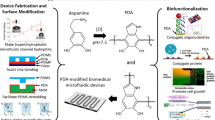Abstract
We have evaluated five bioconjugation chemistries for immobilizing DNA onto silicon substrates for microfluidic biosensing applications. Conjugation by organosilanes is compared with linkage by carbonyldiimidazole (CDI) activation of silanol groups and utilization of dendrimers. Chemistries were compared in terms of immobilization and hybridization density, stability under microfluidic flow-induced shear stress, and stability after extended storage in aqueous solutions. Conjugation by dendrimer tether provided the greatest hybridization efficiency; however, conjugation by aminosilane treated with glutaraldehyde yielded the greatest immobilization and hybridization densities, as well as enhanced stability to both shear stress and extended storage in an aqueous environment. Direct linkage by CDI activation provided sufficient immobilization and hybridization density and represents a novel DNA bioconjugation strategy. Although these chemistries were evaluated for use in microfluidic biosensors, the results provide meaningful insight to a number of nanobiotechnology applications for which microfluidic devices require surface biofunctionalization, for example vascular prostheses and implanted devices.






Similar content being viewed by others
References
Erickson D, Liu XZ, Venditti R et al (2005) Anal Chem 77:4000–4007
Ng JKK, Liu WT (2006) Anal and Bioanal Chem 386:427–434
Dawson E, Moore C, Smagala J et al (2006) Anal Chem 78:7610–7615
Zammatteo N, Jeanmart L, Hamels S et al (2000) Anal Biochem 280:143–150
Wang YY, Prokein T, Hinz M et al (2005) Anal Biochem 344:216–223
Fritz J, Baller MK, Lang HP et al (2000) Science 288:316–318
Wang AF, Tang HY, Cao T et al (2005) J Colloid Interface Sci 291:438–447
Szczepanski V, Vlassiouk I, Smirnov S (2006) J Membr Sci 281:587–591
Anker JN, Hall WP, Lyandres O et al (2008) Nat Mater 7:442–453
Vollmer F, Arnold S (2008) Nat Methods 5:591–596
Mandal S, Erickson D (2008) Opt Express 16:1623–1631
Aretaki IN, Koulouridakis P, Kallithrakas-Kontos N (2006) Anal Chim Acta 562:252–257
Pathak S, Singh AK, McElhanon JR et al (2004) Langmuir 20:6075–6079
Keighley SD, Li P, Estrela P et al (2008) Biosens Bioelectron 23:1291–1297
Lee CY, Nguyen PCT, Grainger DW et al (2007) Anal Chem 79:4390–4400
Southern E, Mir K, Shchepinov M (1999) Nat Genet 21:5–9
Shchepinov MS, Case-Green SC, Southern EM (1997) Nucleic Acids Res 25:1155–1161
Pirri G, Chiari M, Damin F et al (2006) Anal Chem 78:3118–3124
Le Berre V, Trevisiol E, Dagkessamanskaia A et al (2003) Nucleic Acids Res 31:e88
Bhatnagar P, Mark SS, Kim I et al (2006) Adv Mater 18:315–319
Benters R, Niemeyer CM, Drutschmann D et al (2002) Nucleic Acids Res 30:e10
Caminade AM, Padie C, Laurent R et al (2006) Sensors 6:901–914
Cote GL, Lec RM, Pishko MV (2003) IEEE Sens J 3:251–266
Erickson D, Li DQ, Krull UJ (2003) Anal Biochem 317:186–200
Becker H, Locascio LE (2002) Talanta 56:267–287
Bange A, Halsall HB, Heineman WR (2005) Biosens Bioelectron 20:2488–2503
Ros A (2008) Anal Bioanal Chem 390:799–800
Tegenfeldt JO, Prinz C, Cao H et al (2004) Anal Bioanal Chem 378:1678–1692
Wei CW, Cheng JY, Huang CT et al (2005) Nucleic Acids Res 33:e78
Dittrich PS, Tachikawa K, Manz A (2006) Anal Chem 78:3887–3907
Duffy DC, McDonald JC, Schueller OJA et al (1998) Anal Chem 70:4974–4984
PAMAM Dendrimers (2008) Dendritech, Midland, MI. http://www.dendritech.com/pamam.html. Accessed 08 Dec 2008
Coates J (2000) In: Meyers RA (ed) Encyclopedia of analytical chemistry. Wiley, Chichester
Kempfert KD (2007) Spectroscopy 22:22–23
Kurth DG, Bein T (1995) Langmuir 11:578–584
Parrott MC, Valliant JF, Adronov A (2006) Langmuir 22:5251–5255
Haba Y, Harada A, Takagishi T et al (2004) J Amer Chem Soc 126:12760–12761
Kawahara J, Ohmori T, Ohkubo T et al (1992) Anal Biochem 201:94–98
Whipple EB, Ruta M (1974) J Org Chem 39:1666–1668
Migneault I, Dartiguenave C, Bertrand MJ et al (2004) BioTechniques 37:790–802
Saiyed ZM, Sharma S, Godawat R et al (2007) J Biotechnol 131:240–244
Pal S, Kim MJ, Song JM (2008) Lab Chip 8:1332–1341
Steel AB, Levicky RL, Herne TM et al (2000) Biophys J 79:975–981
Niu YH, Sun L, Crooks RA (2003) Macromolecules 36:5725–5731
Cakara D, Kleimann J, Borkovec M (2003) Macromolecules 36:4201–4207
Quail M (2005) DNA: mechanical breakage. Encyclopedia of life sciences. John Wiley & Sons, Ltd, Chichester
Panton RL (1996) Incompressible flow, 2nd edn. Wiley, New York
Hermanson GT (1996) Bioconjugate techniques. Academic, New York
Lee HJ, Nedelkov D, Corn RM (2006) Anal Chem 78:6504–6510
Bencina M, Babic J, Podgornik A (2007) J Chromatogr. A 1144:135–142
Wong AKY, Krull UJ (2005) Anal Bioanal Chem 383:187–200
Acknowledgments
Support for this work was provided by the National Institutes of Health-National Institute of Biomedical Imaging and Bioengineering (NIH-NIBIB) under grant number R21EB007031. This work made use of STC shared experimental facilities supported by the National Science Foundation under Agreement No. ECS-9876771. The authors gratefully acknowledge Dr. Sam Nugen and Prof. Antje Baeumner for technical assistance in determining hybridization conditions and Sudeep Mandal for preparation of PDMS master.
Author information
Authors and Affiliations
Corresponding author
Electronic supplementary material
Below is the link to the electronic supplementary material.
Fig. S1
Schematic of DNA immobilization and microfluidic hybridization assays. Immobilization of DNA in spots defined by a PDMS mask is depicted in the image in the back. After immobilization of DNA, a microfluidic channel (1 mm × 2 cm × 45 μm) is aligned over the immobilized DNA, and target DNA is made to flow through the channel at 2 μl/min, as depicted in the image in the front. (PDF 1017 kb)
Rights and permissions
About this article
Cite this article
Goddard, J.M., Erickson, D. Bioconjugation techniques for microfluidic biosensors. Anal Bioanal Chem 394, 469–479 (2009). https://doi.org/10.1007/s00216-009-2731-y
Received:
Revised:
Accepted:
Published:
Issue Date:
DOI: https://doi.org/10.1007/s00216-009-2731-y




